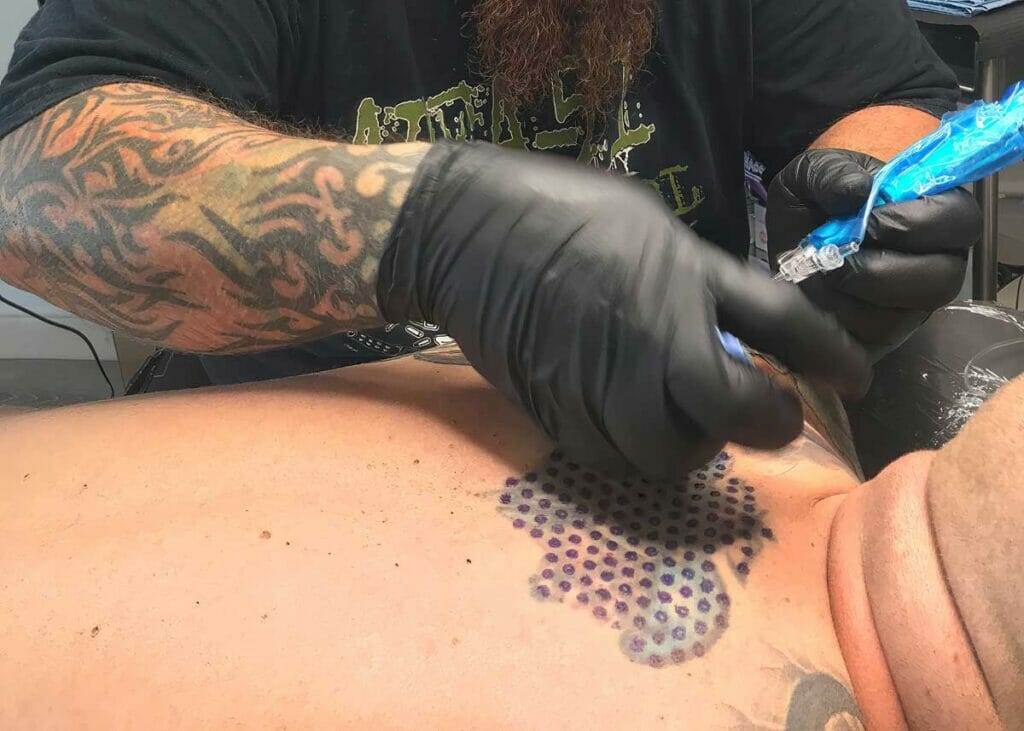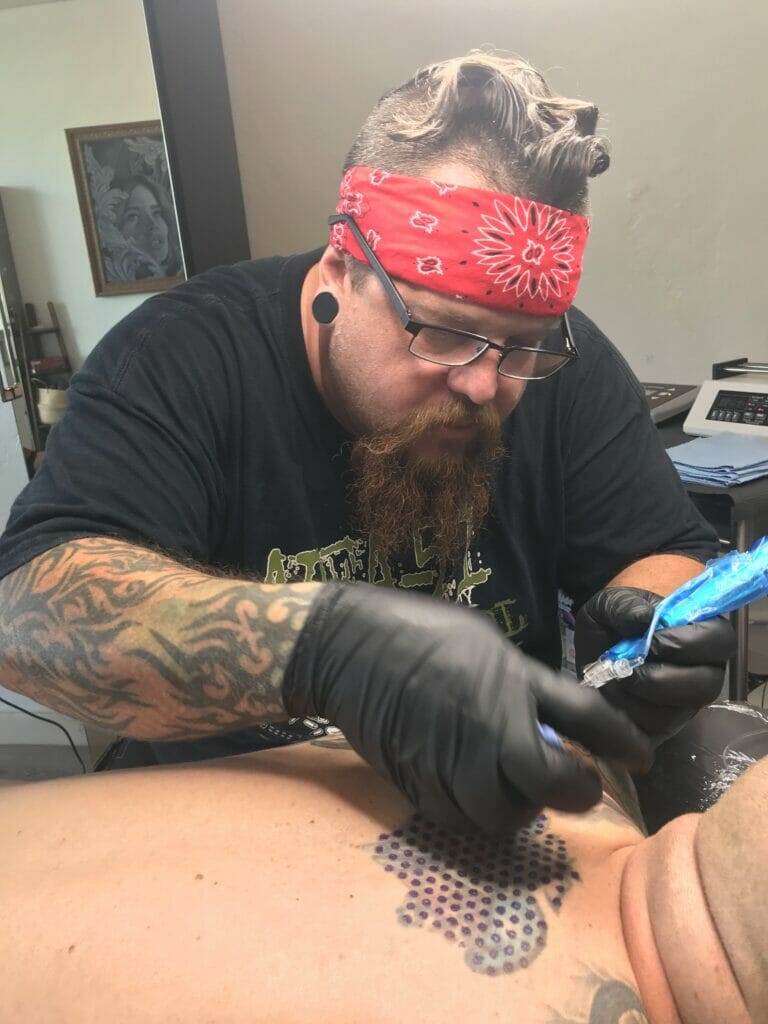Overview of non-laser tattoo removal
Non-laser tattoo removal refers to various techniques used to remove tattoos without the use of laser technology. These methods use different mechanisms to break down the ink pigments and stimulate the natural healing process of the skin to remove the tattoo gradually. Some of the popular non-laser tattoo removal techniques include:
- Salabrasion: This method involves rubbing salt into the tattooed area to remove the top layers of the skin and fade the tattoo.
- Dermabrasion: In this technique, a high-speed rotary device is used to remove the top layers of the skin, along with the tattoo ink.
- Chemical peels: Chemical solutions are applied to the tattooed area to exfoliate and fade the tattoo over time.
- Tattoo removal creams: These creams contain ingredients that claim to break down the tattoo ink and lighten the tattoo with repeated application.
Advantages of non-laser tattoo removal techniques
Non-laser tattoo removal techniques offer certain advantages over laser tattoo removal, which is a commonly used method. Some of these advantages include:
- Cost: Non-laser tattoo removal methods are generally more affordable compared to laser treatments, making them a viable option for individuals on a budget.
- Availability: Non-laser tattoo removal methods can be performed by trained professionals or even at home with the use of certain creams or products, making them more accessible for people who might not have easy access to specialized laser tattoo removal clinics.
- Skin type suitability: Non-laser techniques may be suitable for individuals with darker skin tones or sensitive skin, as laser treatments may pose a higher risk of complications.
- Gradual fading: Non-laser methods work by gradually fading the tattoo over time, which can be favorable for individuals who prefer a more natural-looking, gradual removal process.
While non-laser tattoo removal techniques may offer certain advantages, it is essential to consult with a qualified professional to determine the most suitable method for tattoo removal based on individual circumstances and tattoo characteristics.
Chemical Tattoo Removal
How chemical tattoo removal works
Chemical tattoo removal is a non-laser technique that uses chemical solutions to break down the ink pigments in a tattoo. The chemicals are typically applied to the tattooed area and work to fade the tattoo over time. The process involves exfoliating the skin and stimulating the natural healing process to gradually remove the tattoo.
Different types of chemical tattoo removal methods
There are several different types of chemical tattoo removal methods available. Some of the popular techniques include:
- Salabrasion: This method involves using a salt solution to rub the tattooed area. The salt helps remove the top layers of the skin and fade the tattoo.
- Dermabrasion: In dermabrasion, a high-speed rotary device is used to remove the top layers of the skin and the tattoo ink.
- Chemical peels: Chemical solutions, such as glycolic acid or trichloroacetic acid, are applied to the tattooed area to exfoliate the skin and fade the tattoo.
- Tattoo removal creams: These creams contain ingredients that claim to break down the tattoo ink and lighten the tattoo with repeated application.

Each method has its own benefits and limitations, so it is important to consult with a qualified professional to determine the most suitable chemical tattoo removal method for individual circumstances. Additionally, it is crucial to follow proper aftercare instructions and monitor the healing process to avoid any complications.
Overall, chemical tattoo removal techniques provide an alternative to laser tattoo removal, offering a more budget-friendly and accessible option for individuals looking to fade or remove their tattoos. However, it is important to seek professional guidance to ensure the safety and effectiveness of the chosen method.
Dermabrasion and Microdermabrasion
Dermabrasion and microdermabrasion techniques for tattoo removal
Dermabrasion and microdermabrasion are two common techniques used for tattoo removal. These methods involve removing the top layers of the skin to fade the tattoo over time.
Dermabrasion is a more aggressive technique that uses a high-speed rotary device to mechanically exfoliate the skin and remove the tattoo ink. The device is used to abrade the skin, causing controlled damage to the tattooed area. As the skin heals, the tattoo ink gradually fades. Dermabrasion can be an effective option for removing tattoos, but it may require multiple sessions and can cause discomfort during and after the procedure.
On the other hand, microdermabrasion is a less invasive technique that uses a handheld device to exfoliate the skin with tiny crystals or a diamond-tipped wand. This method is less aggressive compared to dermabrasion, making it suitable for individuals with sensitive skin or those who prefer a gentler approach. Microdermabrasion works by stimulating the skin’s natural healing process and gradually fading the tattoo over time. However, it may also require multiple sessions to achieve satisfactory results.
Benefits and limitations of dermabrasion and microdermabrasion
Both dermabrasion and microdermabrasion have their own benefits and limitations when it comes to tattoo removal.
Dermabrasion:
- Can effectively remove tattoos, even those with deep ink penetration
- Suitable for larger tattoos or areas with dense ink
- May cause discomfort during and after the procedure
- Requires longer healing time compared to microdermabrasion
- May not be suitable for individuals with sensitive skin or certain skin conditions
Microdermabrasion:
- Less aggressive and more gentle on the skin
- Suitable for smaller tattoos or areas with lighter ink
- Generally more affordable compared to dermabrasion
- Minimal downtime and quick recovery
- May require multiple sessions for optimal results
It is important to consult with a qualified professional to determine the most appropriate technique for tattoo removal based on individual circumstances. Dermabrasion and microdermabrasion can be effective options for fading or removing tattoos, but proper aftercare and monitoring of the healing process are crucial to avoid any complications.
Salabrasion
Salabrasion is another technique commonly used for tattoo removal. While dermabrasion and microdermabrasion involve mechanical exfoliation, salabrasion utilizes a different approach to fade tattoos over time.
The process of salabrasion for tattoo removal
Salabrasion involves the use of a salt solution to remove tattoo ink from the skin. Here is a step-by-step breakdown of the process:

- Numbing: A local anesthetic is applied to the tattooed area to minimize discomfort during the procedure.
- Salt solution: A mixture of salt and water is applied to the tattooed area and allowed to sit for about thirty minutes. The salt acts as an abrasive agent, gradually exfoliating the skin and removing the tattoo ink.
- Abrasion: After the salt solution has soaked into the skin, a handheld device with an abrasive pad or sandpaper-like material is used to gently scrub the tattooed area. This helps to further loosen and remove the tattoo ink.
- Healing: Following the abrasion, the area is cleaned and bandaged. The skin will then begin to heal, and over time, the tattoo will fade as new layers of skin replace the treated area.
Effectiveness and risks associated with salabrasionSalabrasion can be an effective technique for tattoo removal, but there are several important factors to consider:
- Effectiveness: Salabrasion is generally more effective for superficial tattoos or those with lighter ink. Deeply inked tattoos may require multiple sessions for optimal results.
- Risks: Salabrasion can cause discomfort during the procedure and may result in temporary redness, swelling, or scarring. It is essential to follow proper aftercare instructions to minimize these risks and promote optimal healing.
- Consultation: It is crucial to consult with a qualified professional to assess if salabrasion is the most suitable technique for tattoo removal based on individual circumstances.
In conclusion, salabrasion is a tattoo removal technique that utilizes a salt solution to gradually fade tattoos over time. While it can be effective, it is essential to consider the risks and consult with a professional for proper assessment and guidance throughout the process.
Tattoo Removal Creams and Gels
How tattoo removal creams and gels work
Tattoo removal creams and gels are another option for removing tattoos without undergoing invasive procedures. These products typically contain ingredients designed to break down the tattoo ink and gradually fade the tattoo over time. The process involves the following steps:
- Application: The cream or gel is applied directly to the tattooed area and massaged into the skin. The active ingredients penetrate the skin and target the tattoo ink.
- Ink breakdown: The ingredients in the cream or gel work to break down the ink particles into smaller fragments. This allows the body’s natural processes to flush them out over time.
- Continued use: Tattoo removal creams and gels usually require regular and consistent use for several months to see noticeable results. It is important to follow the instructions carefully and be patient during the process.
Popular brands and their effectiveness
There are several popular brands of tattoo removal creams and gels available on the market. These brands claim to offer effective tattoo removal results, but it is important to note that individual experiences may vary. Here are a few examples of popular brands and their reputation:
- Tattoo Off: This brand claims to offer a non-laser, pain-free solution for tattoo removal. Some users report positive results with fading tattoos, while others may not see significant changes.
- Wrecking Balm: Known for its unique three-step process, Wrecking Balm offers a combination of cream, exfoliating scrub, and fading serum. Some users have reported seeing noticeable fading after consistent use.
- Tattoo Vanish: This brand claims to remove tattoos using natural ingredients. While some users have had positive experiences with Tattoo Vanish, others may not see the same level of effectiveness.
It is important to keep in mind that tattoo removal creams and gels may not be as effective as other professional treatments such as laser removal or salabrasion. It is always recommended to consult with a qualified professional to determine the most suitable tattoo removal method for individual circumstances.






